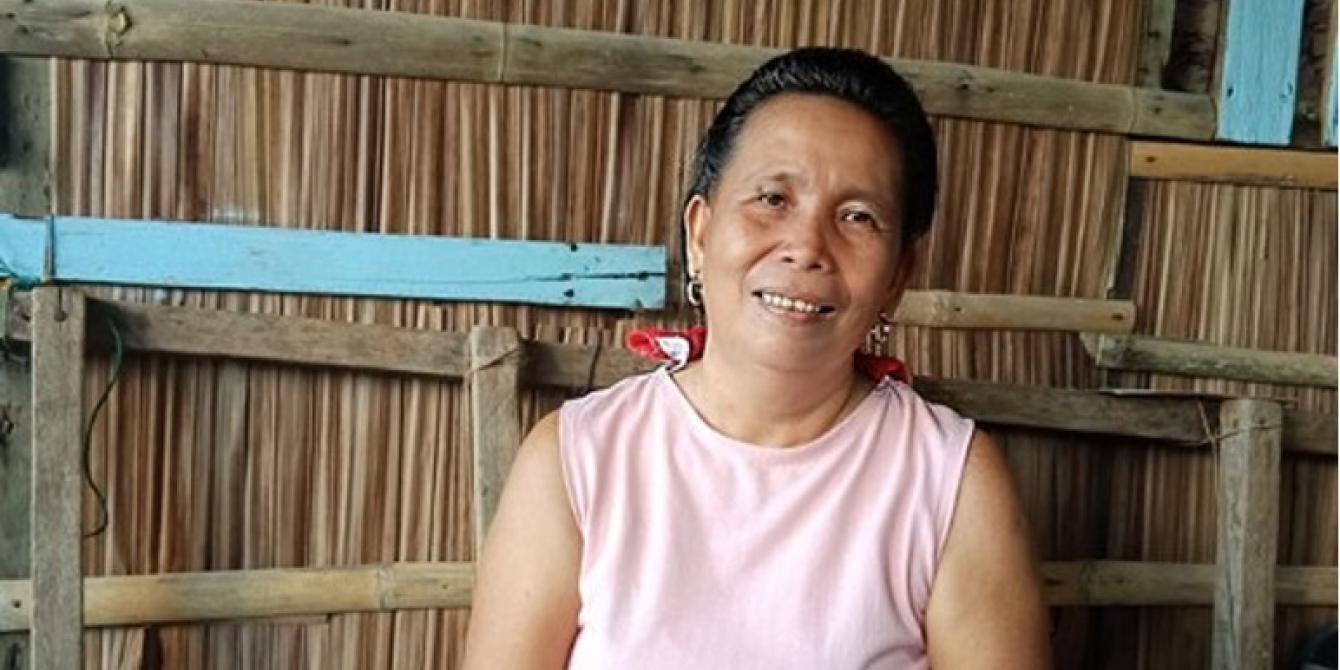Disaster preparedness should be a way of life

Cristina in her house at Barangay Matriano (Photo: PDRRN)
Cristina, 50, is a mother from Barangay Matarinao, Salcedo, Eastern Samar. She and her husband, a fisherman,support an extended family consists of their two children and several grandchildren with whom they share the same household. To help make ends meet, Cristina works as a utility woman in her town’s Barangay Office.
Barangay Matarinao is a coastal town in the northern tip of Salcedo. Due to its geographic location, facing thePacific Ocean in the eastern portion and a common typhoon path during the monsoon season, BarangayMatarinao is one of the most calamity-prone areas in the region.
These natural hazards that have intensified over the years is one of the major factors that worsen the povertysituation in the region due to their severe impacts on the people’s sources of income, which are primarily farming and fishing.
In June 2019, Cristina’s family qualified to be part of the B-READY Project and the heads of households —in the case of her family, her husband — were invited to join the orientation and trainings.
“Since my husband is always away working at sea, I stood as my family’s representative in communityactivities, including B-READY. I joined all the sessions from the orientation to the community drills,” Cristina shared.
Part of the learning sessions conducted by the PDRRN, B-READY Project’s local implementing partner, are financial literacy training, prepaid card distribution and user’s education for recipient families. Registering for a digital financial account and acquiring a prepaid card (called iAFFORD) is part of the disaster preparedness intervention to provide a means for communities to avail of financial services and be able to purchase basic goods such as food, water and medicines, to evacuate, and to repair their homes with pre-disaster cash grants. But like other project participants, Cristina has never had a prepaid card and was notfamiliar with digital financial technologies.
“[During the User’s Training] I learned that there were many uses of the iAFFORD PayMaya card. It serves as mysavings account where I can deposit cash. And if my two children working in Manila want to send us financialsupport, they could deposit money in my iAFFORD account at any financial service provider (such as SmartPadala Center* and Palawan Pawnshop**) and I will receive it directly in my iAFFORD account.”
“It was a big help to us because we did not have to go to other communities to withdraw money because there is a merchant here in our Barangay,” said Cristina.
She was referring to her neighbour, Mr. Emeliano Daiz, a sari-sari store owner and an accredited and trainedcommunity-based financial service provider or micro-merchant of the B-READY Project. This is one of theproject’s strategies to strengthen local communities’ financial ecosystems by expanding communities’ accessto payment and disbursement channels, before and during emergencies.
Facing Typhoon Phanfone
In December 2019, the devastating Typhoon Phanfone (local name: Ursula) ravaged the country, traversingthrough Eastern Samar on Christmas Eve. The typhoon brought rains for three days causing surges incoastal communities, including Barangay Matarinao. Cristina’s family, along with more than 900 others, was evacuated from danger zones to the nearest safer ground. Each of the project’s recipient families received a total of PHP 1,700 (EUR 32) as a multi-purpose cash transfer which they could use to buy their most urgent needs.
“The cash support was a big help to us. When we received it, we immediately bought food. We also bought medicines because one of us had fever and cough”.
The training and the seminars that Cristina attended also helped her realize the value of preparedness.
“The community drills taught us lessons to keep our families safe during times of disasters and calamities.This experience allowed me to apply the lessons I’ve learned in the seminars. I have learned to prepare our hygiene kits and Go Bags so we can carry them when we need to evacuate fromour house. It is important that we prepare our food, mat, flashlight, medicines, and other necessities. Now, if we need to evacuate, we will not hesitate to go to the evacuation center for the safety of our whole family.Now, we are not worried.”
Lessons for life
Looking back, Cristina feels she has not only learned lessons about disaster preparedness, but also onesthat she could apply to other areas of her life.
“The biggest lesson I have learned is how to wisely spend and save my money. So, when there are calamities, somehow, I have some cash, and I will be ready. It is not wise to keep on spending, but rather, I should deposit or save my cash in my iAFFORD PayMaya account.”
###
The Building Resilient, Adaptive, and Disaster-Ready Communities (B-READY) Project is a two-year pilot project that aims to better protect vulnerablehouseholds from natural disasters through a pre-disaster cash transfer program using two innovations: first, the use of digital weather forecasting and risk modeling technologies as part of the local communities’ early warning systems (EWS) and trigger mechanisms for early response; and second, the use of financial services provision technologies and a local financial ecosystem that would allow for safe and secure pre-disaster cash transfer programming.
The B-READY project was a collaboration of a consortium of partners, namely: Local Government of Salcedo, Eastern Samar; People’s Disaster Risk Reduction Network; PayMaya Philippines; Global Parametrics; and Plan International. Over the past two years, the project reached almost 9,300 individuals in nine barangays (villages) in Salcedo with access to digital financial services, literacy trainings, and pre-disaster cash grants for two devastating typhoons; supported theaccreditation of 17 community-based cash agents for disbursement of cash grants; jointly developed and tested the triggers of typhoon parametric index; strengthened safeguarding mechanisms during emergencies; and facilitated local government adoption of a resolution for using parametric index as part of disaster EWS.

 Follow us on Facebook
Follow us on Facebook Instagram
Instagram Follow us on Twitter
Follow us on Twitter LinkedIn
LinkedIn